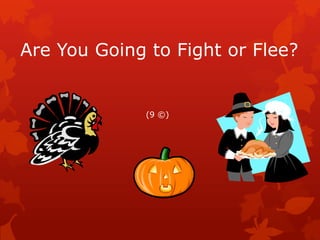
Are you going to fight or flee
- 1. Are You Going to Fight or Flee? (9 ©)
- 2. Meninges and Spinal Fluid (8 ©) Ventricles Central Canal
- 3. Infection and inflammation of the meninges is termed meningitis, and involves the arachnoid and pia mater, or the leptomeninges. Spinal fluid, three distinct layers: Dura mater, arachnoid membrane, and pia mater. Because the brain and spinal cord are both delicate and vital, nature has provided them with two protective coverings. The outer covering consists of bone: cranial bones encase the brain; vertebrae encase the spinal cord. The inner covering consists of membranes known as meninges. Epidural space- The epidural (“on the dura”) space is immediately outside the dura mater but inside the bony coverings of the brain and spinal cord. It contains a supporting cushion of fat and other connective tissues. Subdural space: the subdural (“under the dura”) space is between the dudra mater and the arachnoid membrane. It contains a small amount of lubricating serous fluid. Subarachnoid space- It is under the arachnoid and outside the pia mater. This space contains a significant amount of cerebrospinal fluid. Cerebrospinal fluid is found in the subarachnoid space around the brain and spinal cord and within the cavities and canals of the brain and spinal cord (2).
- 4. Structure and Function of the Spinal Cord (8 ©)
- 5. The Spinal Cord is like the brain, it is completely encased in bone. It resides within the vertebral column and connects directly to the medulla section of the brain. In an adult, the spinal cord is approximately 45 centimeters long. It receives sensory messages and sends motor messages straight to the brain. There are 6 sections of the spinal cord 3 vertebrae sections and 3 nerve sections; C1-C7 is the Cervical Vertebrae, T1-T12 is the Thoracic Vertebrae, and last is the Lumbar Vertebrae L1-L5. On the nerve side, C1-C8 is the Cervical Nerves, T1-T12 are the Thoracic Nerves and L1-L5 are the Lumbar nerves.
- 6. Brain Stem, Cerebellum Cerebrum (8 ©) Cerebrum (9 ©) Cerebellum
- 7. The brain step has three major parts: Medulla Oblongata, Pons, and Midbrain. The medulla oblongata is like a turkey neck as it is an “extension of the spinal cord” (2). It is located directly beneath the pons. It also has reflex centers inside of it, but mainly for issues concerning the throat. Most of the peripheral nerves are located in the pons, which are directly above the medulla. They also “help regulate respiration” (2). The midbrain is the part of the neck that you don’t want to brake. Unless you want to stop moving your eyes and look like your ready to have an apple put in you r mouth to be served on the table.
- 8. The cerebellum (9 ©) • 2nd largest part of the brain!!! • It has 3 cerebellar peduncles: inferior, middle, and superior. • It helps to provide special movements along with the cerebral cortex (2). • Helps you stand tall and proud like a pilgrim. • Maintain balance so that you can run, sit straight, and enjoy Thanksgiving meals with your family. (9 ©)
- 9. Diencephalon Contains the Thalamus, and the Hypothalamus. The thalamus interprets impulses of pain. It helps our brain recognize when we are hurt or not. The hypothalamus helps regulate body temeperature, “synthesizes hormones,” helps the body stay awake (useful during school), and keeps the appetite in check (takes vacation time during Thanksgiving) (2).
- 10. Cerebral Cortex VOCAB : Fissure: deep grooves Sulci: shallow grooves Gyri: convultions (2). Each section of the cerebral cortex has different functions: sensory, motor, mixed. Some of the special functions the cortex has are monitoring consciousness, interpreting language, controlling emotions, and retaining memory (2). EEGs are tests that allow doctors and scientists to monitor the cortex’s activity (2).
- 11. Somatic Sensory Pathways in the Central Nervous System Impulses must be conducted to its sensory areas by way of relays of neurons referred to as sensory pathways. There are three different types of sensory neurons; primary, secondary, and tertiary sensory neurons. Primary sensory neurons go from the periphery to the central nervous system. Secondary sensory neurons go from the cord or brainstorm up to the thalamus. Tertiary sensory neurons go from the thalamus to the postcentral gyrus of the parietal lobe. Each side of the brain registers sensations from the opposite side of the body. (1)
- 12. (8 ©)